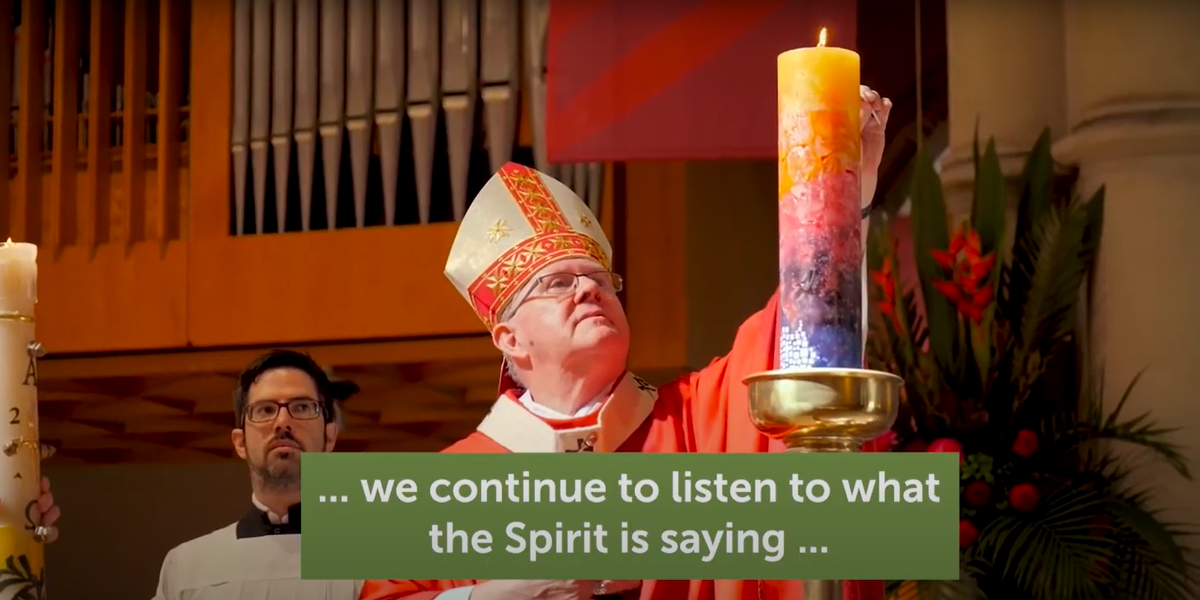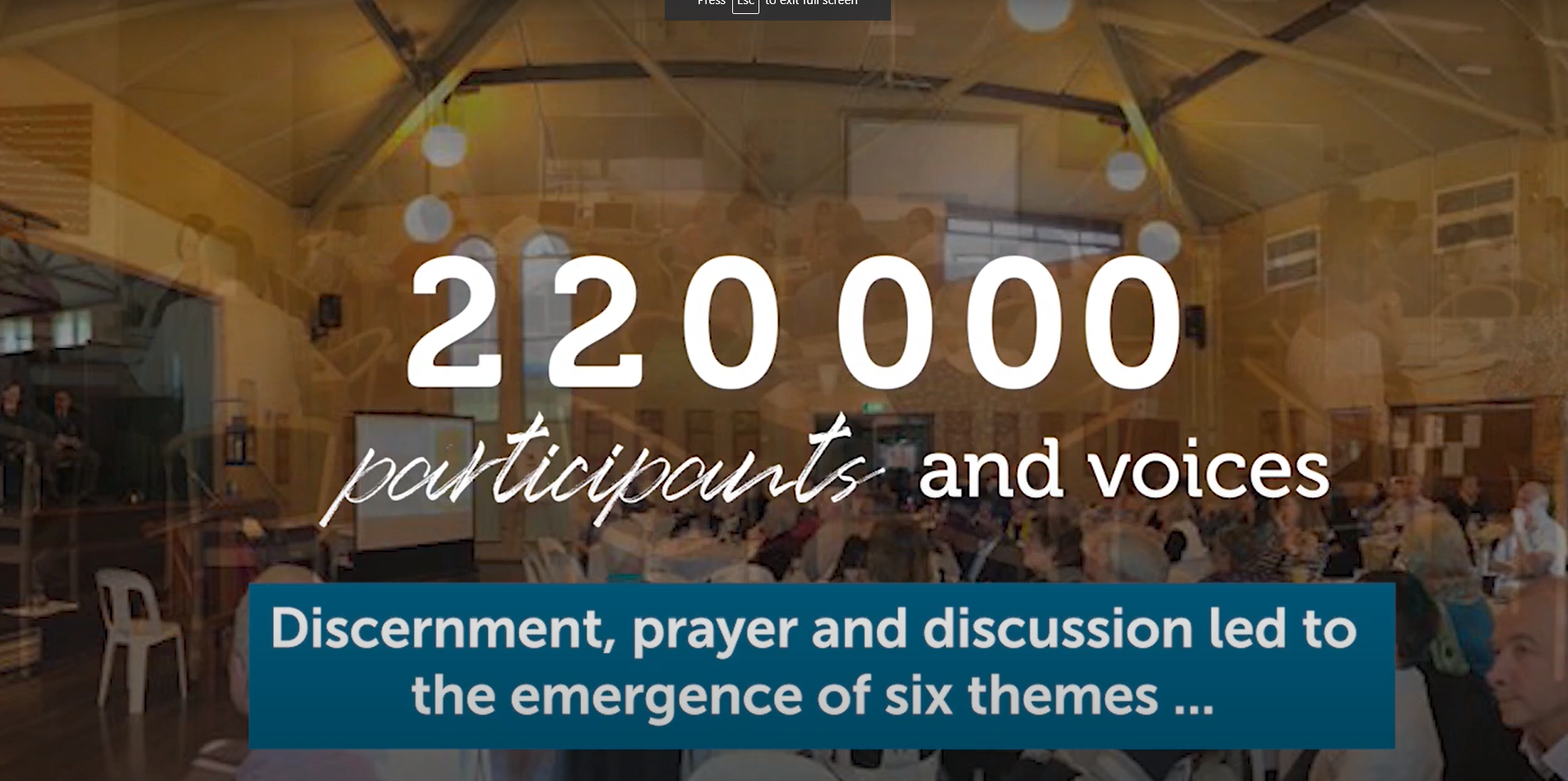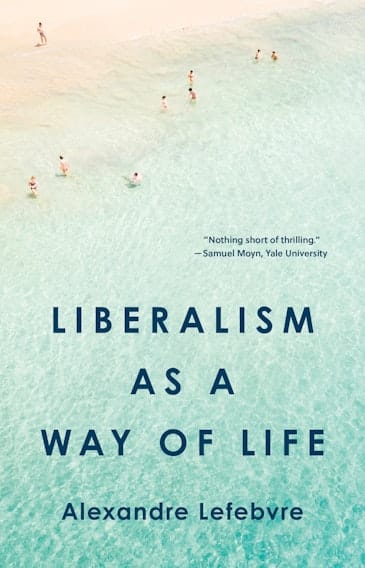Synodal Investigations 2: Is a spiritual conversation a sacrament?
Are sacraments technologies? What about spiritual conversations? Synodal Investigations continues with an inquiry into the synodal process's key technique

The central technology of synodality, and the experience most people have of what synodality involves, is called the “listening session” or “spiritual conversation.” Many Catholics have loved them, saying the synodal process has made them feel listened to for the first time. Others have complained about them, saying they lead to pre-determined outcomes. But in this post I will do something that, as far as I can tell, nobody else has bothered to do: ask what a spiritual conversation actually is, as far as the Catholic Church’s sacramental life is concerned.
Before I launch into it, thank you to everyone who has read and provided feedback on the introduction and first part of Synodal Investigations. I’d especially like to express my gratitude to the kind souls who told me the first section was too long. I’ll do my best to keep this one under eight thousand words, for all the lazy readers out there.
Also, a disclaimer: as I said in earlier posts, I am not trying to do academic theology, but sketch out and review certain of my own thoughts on what I have observed and read in recent years. If I don’t hit the mark, so be it—as Chesterton says, anything worth doing is worth doing badly.
Whose church? Which sacraments?

Years ago I was told by a friend (who is now ordained and a fine priest) that he’d heard of corrupt priests going around saying the words of consecration over trucks full of Tip Top white bread. The trucks would drive away chock full of loaves of spongy white eucharists, for unsuspecting punters to turn into consecrated ham and cheese sandwiches, prisoners of the plastic tabernacles of their children’s lunchboxes. To cause this mass sacrilege, all that was necessary was to a validly ordained priest to stand near the truck and say the words—”this is my body, this is my blood” and so on—and make the correct gestures. I don’t think he believes this kind of thing now.
Nevertheless this is the view of “how the priest makes the eucharist” that most Christians have. The priest, standing at the altar, performs the ritual gestures and says the words. Because of the power of ordination, at a certain “moment” he causes the eucharistic host to change from mere bread and wine into the body and blood of the One Lord, Jesus Christ. At this point, the communion wafer has grace baked in and consuming it means one consumes the grace, like the active ingredient in medication. If this seems reductive, I’m sorry. Most Catholics who believe in the real presence of Christ in the eucharist believe something like this.
The priest is in this regard the instrumental cause of the consecration of the eucharist—he causes it to happen, but God is the principal cause working through him. As Suarez puts it, "an instrumental cause is said to be a cause that concurs in, or is elevated to, the production of something more noble than itself … in general, an accident insofar as it concurs in producing a substance.”
The theologian Ivan Illich traced this idea of instrumentality back to the the 13th century and the scholastics, beginning with Hugh of St Victor and Thomas Aquinas, and drew what seems like a fairly straightforward conclusion: a sacrament is an instrument, a tool. The church has a variety of blessings, but “theologians … found the term instrumentum extremely useful for naming seven among these blessings as so special as to require the separate category of sacraments,” Illich said. A priest is a kind of operator who “uses” sacraments as tools to instrumentally cause contingent changes in the world, with God as the principal cause. The church “has” seven sacraments, which are its toolkit; the clergy are a guild of qualified and licensed operators of these tools, and so on. Perhaps the ultimate expression of this view came in the eucharistic ecclesiology of last century, which said that “the eucharist makes the church.”
The view is somewhat different in the Orthodox and Oriental Catholic churches, which have tended to retain the view that whatever the church is, it does not “have” sacraments but is itself the “ur-sacrament”, the sign of Christ’s own mysterious presence in the world. It’s easier to depict than explain. For instance, as anyone who has made a confession in the Byzantine tradition knows, the priest does not say ego te absolvo, “I absolve you.” Rather, confession proceeds with the frank acknowledgment that the priest is not an operator:
“Behold, my spiritual children, Christ stands here invisibly, and receives your confession.”
The absolution sometimes takes the Roman form in those churches subject to more Latin influence, but one more traditional formula goes:
“The Lord God through Nathan the Prophet forgave David his sin, and the adulteress weeping at his feet, and Peter shedding bitter tears for his betrayal, and the Publican and the Prodigal Son. May this same Lord and God through me a sinner, forgive you, N., all the sins of your life, in this world and in the world to come. And may He make you stand uncondemned at his awesome tribunal, for He is blessed for ever and ever. Amen.”
Likewise the priest does not touch the eucharistic host during “the consecration”. Orthodox do not even really think of a definite “moment” of consecration, so to speak (perhaps the second epiclesis), and reverence even the “unconsecrated” bread as it is processed into the altar. The priest only gestures to the host while he says the words of institution. The truck of Tip Top situation is just impossible under these conditions.
If the church is the “ur-sacrament”—or as Nicholas Cabasilas thought, the sacraments were nothing more or less than the deifying life in Christ—a variety of ritual acts can be considered sacramental and the priest is a sign or image of Christ who performs them, rather than an instrumental cause. Some easterners will think of the great blessing of waters as a sacrament, or monastic tonsure, or funerals. It’s also the case that unordained monks have heard confessions and absolved penitents, that hermits have been said to receive the eucharist directly from angels from the altar on high and so on. The notion of instrumentality is much weaker; you might say that at the Divine Liturgy the epicletic action of the Holy Spirit both consecrates the bread and parts the veil, so the congregation may noetically intuit the eucharist for what it really is, the reality of God’s loving sacrifice and dwelling on earth revealed, in a piece of bread and cup of wine.
Such a view is much closer to the real meaning of the classic sacramental definition: a visible sign of invisible grace. By this, we don’t mean that there’s invisible grace “in” the visible baptismal water or “in” the oil of unction, like a secret ingredient. Rather the actions of the priest signify and show forth the gracious work God himself is performing, which is perceived and received by faith.
This isn’t to say that the average Orthodox or Eastern Catholic doesn’t share the vulgar view that the priest “makes” the eucharist—they probably do. But since Vatican II the Latin church has done much to reinvigorate the premodern sense of the church as a sign, a sacrament, a mystery, alongside the instrumental theology. The first chapter of Lumen Gentium puts it plainly
“Since the Church is in Christ like a sacrament or as a sign and instrument both of a very closely knit union with God and of the unity of the whole human race, it desires now to unfold more fully to the faithful of the Church and to the whole world its own inner nature and universal mission.” [Emphasis mine]
Synodal theology skips this chapter and goes straight to chapter two on the People of God, as I showed in the previous section. This is because, as I will now explain, there is no desire on the part of the synodal faction to leave behind the idea of sacraments as tools and return to a premodern integral sense of the church as “ur-sacrament.” In fact, synodality develops the technological nature of modern sacramentality even further.
From eucharist to spiritual conversation // From tool to system

If the Mass is a tool that priests use to manufacture eucharistic hosts, what is a spiritual conversation? It might be useful first to outline how a spiritual conversation works.
The Jesuits, who claim to have invented the technique, have a guide on their website about how a spiritual conversation is meant to proceed. In essence, it goes like this: Participants are given a text or an issue to consider, they ruminate on it in their hearts, discern what God is saying to them, report their discernment to the group, and then after discussion come to a kind of group consensus about what message the Holy Spirit has given them. At a macro level, ordinary lay people have their opinions solicited directly by Rome on a variety of focus questions and submit their answers to the synod’s various stages; they are also polled by their Dioceses, and by various other groups. At a micro level, at the Plenary Council each individual, each table, and the whole assembly were all engaged in these hermeneutic circles of listening, discerning, reporting, listening, discerning, reporting and so on. When the Wednesday Plenary Council protest took place, this was just another instance of spiritual discussion (albeit at a higher level of intensity) to be interpreted, rather than a mistake or a failure of certain motions to succeed.
The raw data from these initial sessions goes into drafting groups, shaped by periti, and working documents emerge that re-propose these data again to the group, this time in processed form. In a circular fashion, it is then fed up and down the chain, and returned to its starting point, for further discernment and conversation. In spiritual conversations there is no argument from authority, whether that be scripture or the saints. After the discussion of what each has received, dialectical argument, disputation or even further elaboration are also proscribed. Only what is discerned through listening to the Spirit is admissible. Indeed, after the initial period of conversation is complete, the Jesuit guide insists that, "It is very important that the group returns to only listening in this phase; there is no discussion on another’s experience of the spirits."
Is this a sacrament? Maybe, but not in the old instrumental sense; a listening session is not a tool. But it is clearly something more than just another “structure” of the church, like a board meeting at a chancery or Catholic agency. After all, spiritual conversations draw their legitimacy from the synodal and conciliar tradition of the church, in which Christ’s promises to be with two or three who gather in his name are taken as a species of epistemic reliabilism. The synodal process claims to really know that God is speaking in these sessions, because synodality is now claimed to have been a constitutive mark of the church from the beginning.
In section one I said synodality is the triumph of hermeneutics as an ecclesiological style. To build on that definition further:
What does this mean? Again, to cite Ivan Illich, who has opened my eyes on this point, systems are essentially “cybernetic”. The word is derived from the Greek κυβερνήτης, meaning a pilot or captain of a ship. Systems regulate, control and direct by forcing data into patterns for analysis, and piloting them through processes in ways that have no regard to the inputs other than their status within the system. Illich and his interpreter David Cayley (in Ivan Illich: An Intellectual Journey, from which these quotes are all taken) remark that for many postmodern thinkers, systems are a force for liberation:
“When Jacques Derrida famously wrote, in Of Grammatology, that “there is no outside text,’ he spoke for everyone who felt themselves to be at the threshold of a new age in which there would be no privileged standpoint, no unquestionable foundation, no unassailable origin. To include oneself as part of the system was simply to acknowledge one’s stake and admit one’s bias.”
But for Illich, systems represent the height of dehumanisation, the reduction of flesh to data, and as such he was dead against them: “postmodernism is incredibly disembodying.” Systems also have the advantage of incorporating users into the system itself. Every computer terminal that is connected to the internet becomes yet another node in the internet, for instance, supplying data that refines the system. “A tool enacts a purpose external to it; a system continuously modifies its own purpose by the incorporation of feedback,” Cayley writes, paraphrasing Illich.

The conclusion should be obvious: the spiritual conversation's move to the centre of church life is the dis-incarnation of the sacramentality of the church, and its transformation into a system. Perhaps this is why synodality has emerged exactly alongside the ubiquitous adoption of Zoom videoconferencing—unlike eucharistic worship, the spiritual conversation can take place without friction in digital spaces. This is because each participant in the conversation is a node, and offers their own individual reflection on what the Holy Spirit (the purported operator of the system—you may disagree) is saying to them. These reflections are then fed through further nodes up the chain, and then returned for further processing or discernment. Negative feedback of the sort the listening sessions have received from traditionalists and conservatives is fed through the system and neutralised. This happens either by being ruthlessly and politely excluded in the drafting committees’ sessions, or by recontextualisation in the final documents, in anodyne statements like, “We also heard voices of lamentation from those who grieve for a Church that is no longer a place of unchanging 'tradition'."
The idea that one participant’s story, witness, or needs might stand against, or convict, the whole system is impossible; every individual testimony is boiled down into a slurry of data points, quotations and documents. Little wonder the protests of this or that conservative cleric or lay theologian have had so little impact on the process, even where those complaints are made from within the College of Cardinals, immediately proximate to the supreme government of the church. No node is more or less important than any other, (even extending to those who are unbaptised) as Pope Francis recently stressed. Under this model, clergy are on par with laity, with the People of God ecclesiology providing a theological rationale for flattening out both the hierarchical ordained-lay distinction, but also the subtler hierarchy of holiness, in which some people truly have obtained a higher degree of spiritual maturity and intimacy with the Lord than others.
Interestingly, the two chief sacraments for synodal thought are baptism and marriage—the two sacraments any person may perform, not just the guild-approved operators, the priests and bishops. Baptism incorporates a person into the church, and is thus the only true sacrament in the synodal theology, insofar as it is the only one that still operates like a tool. Baptism, it seems, is now something like the installation of an operating system on a computer: as soon as you’ve had it, you’re ready to receive messages from God. Marriage is the “networked” sacrament par excellence, because in the Latin church the “operators” of the sacrament are the nodes themselves (in the Eastern churches the priest must bless the couple for the sacrament to be valid). It is taken to be higher than celibacy because it shows that nodes in the system can effectively organise themselves outside of the clerical operators’ control. In this sense, it would be just wrong to deny it to anybody who may desire it, even where the church's teaching says such a marriage would be "impossible." The desire for the return of the communal “third rite” of reconciliation makes more sense when thought of in this way, too. There isn’t an “individual” sin in a system; because there’s no individual person, just networked nodes who commit “social sin” together.
There’s a reason the synodal faction, despite being on average several decades older than “trads”, are more comfortable with technology and networking, and tended to have a much better time hanging out on Zoom during the pandemic, while young fogeys were complaining about vaccines and being locked out of their parishes. Unlike Millennials, who grew up in the 2000s when postmodernity was already giving way to something new (more on this later), Gen X and the younger Baby Boomers are thoroughly postmodern. They are very comfortable with “the slippage between mechanism and model,” (Cayley, quoting Katherine Hayles’ How We Became Posthuman) in which, to use Cayley’s example, “sophisticated visualisation technologies increasingly break down the distinction between the experienced body and the CAT scans, ultrasound probes, and MRIs that represent them.” The synodal relationship between ecclesiology and sacrament is similar: spiritual conversations and the documents emerging from them, as the mechanisms for interpreting the movements of the Spirit, become indistinguishable from the church itself. The installation of hermeneutical processes of interpretation, rumination, critique, meaning-making and the like rise to the first position in ecclesiology, as I’ve already said. The representation of Catholics’ opinions in synodal documents comes to stand in for the real, living church. Yet the synodal process is so systematised that the near-total absence of work and family life from the documents is not felt to be a crisis.
So is a spiritual conversation a sacrament? Perhaps it could be described as a network of visible signs of invisible grace, but that presupposes that the Holy Spirit is really talking to the participants in these sessions. If the Spirit really is talking in these sessions, it's in a thoroughly postmodern way, quite close to what Hayles describes as the "distributed cognition" typical of cybernetic systems. Whether it is a sacrament or not, it has already begun to displace the eucharist as the key activity by which the church comes to understand itself.
The influence of this shift on Catholicism should not be underestimated, because the reduction of the priest and his Mass to one node in a system will change the church in ways for which most Catholics are unprepared. One can easily imagine the Cathedral of each diocese as a liturgical "node" in which large numbers of eucharistic hosts are consecrated by a small number of priests, to be distributed to mission posts and base communities staffed by lay facilitators. After spiritual conversation, discernment and prayer, the facilitator conducts a communion service where the consecrated hosts "manufactured offsite" are distributed and consumed. A version of this is already the norm in some areas of regional Australia, and in many parts of the world where priests are in short supply.
If this vision of the church concerns you, consider this: the Catholic church already exists in a state of provisional post-sacramentality. Most Catholics simply do not believe the eucharist is the "real presence" of Christ. A 2019 Pew survey of US Catholics found around 30 percent believe in the "real presence" and know what the church teaches. Another 20 percent know the church's teaching, and disagree with it. The other half think the church believes the eucharist is merely an empty sign (a "symbol"). The main advantage enjoyed by synodal theology is it takes this reality at face value and does not necessarily think it must be remediated, whereas the John Paul II-Benedict XVI orthodoxy has the unenviable task of catechising and evangelising the 70 percent. Even the practice of silent adoration, the most popular JPII-era devotion for young people, is in a certain regard "post-sacramental" because it alienates the eucharist from its liturgical context for a separate act of devotion.
It bears remembering that adoration emerged as a devotion after the Council of Trent in response to Protestantism, in order to elevate the reified eucharistic concept itself for worship, rather than consumption:
"The other sacraments do not have the power of sanctifying until someone makes use of them, but in the Eucharist the very Author of sanctity is present before the Sacrament is used."
Whereas in Tridentine Christianity adoration could easily be said to be an extension of the adoratio offered during Mass, today's adoration is often counterposed to the parish Mass for the sake of a younger, more traditional crowd—one has Gregorian chant and the Tantum Ergo, the other has daggy Marty Haugen hymns and so on. As I wrote in section one, it is consequently no mystery why the Tridentine Mass is being restricted during the synodal age. Perhaps Benedict XVI's intuition was correct about the practice of the Novus Ordo being dependent, in some sense, on the survival of the Vetus Ordo. We will soon find out.
Post-sacramental Christianity began in 1647

It occurred to me that the spiritual conversation/listening session is very similar to the liturgy of the Religious Society of Friends, otherwise known as the Quakers. I have always had an affinity for the Quakers, even though I’ve never attended their services, and in recent weeks have read a lot of Quaker literature to help me understand what a post-sacramental Christianity might look like. For someone trained in theology by Orthodox they’re easy to love because, despite their sheer oddness, the Quakers share a lot with the Christian east.
Friends, if you’re not familiar with them, are unique among Christian sects because they deny the use of sacraments altogether: they do not baptise with water, celebrate the eucharist, ordain ministers or perform any other "outward rites". They were part of the radical reform and the Puritan movement of the 17th century, and believed firmly that sacraments were not necessary because in the new covenant, Christ has come to teach his people himself. They also thought Christ had inaugurated a new age of the Spirit in their time and in mystical visions to the movement's prophets, promised to gather a new people to himself. St Paul writes: “For as often as ye eat this bread, and drink this cup, ye do shew the Lord's death till he come” (1 Cor 11:26). The Quakers say, “that’s right, and the Lord has come again.”
Their baptism and Holy Communion are purely “inward and spiritual”—no bread or wine. They point to passages in scripture to argue that Christ came to do away with external ordinances altogether: "For God's kingdom does not consist of food and drink, but of righteousness, peace, and joy produced by the Holy Spirit” (Rom 14:17), “I [John the Baptist] indeed baptise you with water unto repentance. but he that cometh after me is mightier than I, whose shoes I am not worthy to bear: he shall baptise you with the Holy Ghost, and with fire” (Mt 3:11). Conservative Quakers think of themselves as a prophetic church, and practice a form of unprogrammed liturgical worship called “waiting worship,” in which they sit in silence for at least an hour and “wait on the Lord.” Anyone who feels the Spirit moving may stand up and speak a prophetic word. I’ve never been, but there’s a charming scene from an old film about Quakers that depicts an obviously idealised version:
They believe the Holy Spirit really descends on the meeting and that Christ speaks through his people. I learned from one source that there is also a practice called “clerking”, in which a clerk tries to discern from the various utterances during the meeting what God is trying to say to the whole group. It’s thought of as a charism of its own, and is quite difficult to do well, I read. The YouTube clip makes it look a bit naff, but increasingly scholars are realising that the early Quaker theology, although pretty sparse, affirmed something close to the Orthodox doctrine of theosis, or divinisation. Primitive Friends thought they really were “partakers of the divine nature”, believing that their sanctification was caused by the immediate indwelling of Christ in their souls by the power of the Holy Spirit. The first Quaker, George Fox, put it this way in The Great Mystery:
[T]hat the saints are the temples of God, and God doth dwell in them, that the scriptures do witness, 2 Cor. vi. 1. Eph. iv. 6. 2 Pet. i. 4. And if God dwell in them, then the divinity dwells in them; and the scripture saith, ye shall be partakers of the divine nature; and this I witness…
Conservative Friends drew the same conclusions from this doctrine as Orthodox: theosis is predicated on asceticism. They accordingly practiced a quite strict and severe manner of life, were teetotallers, committed to plain clothing and truthful speech, didn’t swear oaths, believed in radical equality and were total pacifists. I think some Quakers in the US still live this way today; many seem to be “post-Christian.” There aren’t many left, in any case. In Australia there are around 2000 Quakers.
What matters is you have a fully-formed church community whose entire liturgical life is the “listening session”, founded in the 1600s, with absolutely no notion of systems thinking whatsoever. In fact, Quakers think of the visitation of God in these sessions as Holy Communion, direct communion with God in a totally immediate way with no instrumentality: no priest, no tool, no system, no creeds. In a certain sense the very existence of this kind of community casts the synodal spiritual conversation/listening session in an unflattering light indeed, for two reasons.
First, the “nominalist” conception of what God is doing during synodal listening sessions is quite dismal compared to the divinising beliefs of the Quakers. God’s Word, received in waiting worship in the meeting house, was thought to sanctify, prompt to conversion, and inspire to justice, peace, forgiveness and longsuffering. Whether you are prepared to think that the Holy Spirit does speak to unbaptised Quakers, in the synodal sessions of baptised Catholics the Spirit seems mostly to inspire familiar, secular critiques and proposals for governance reforms. Second, because the primitive Quakers believed a strict rule of life was necessary for the individual to receive God in the meeting (wait until you see the way they governed themselves corporately!), the question must be asked: what is the relationship between asceticism and synodality? The old practice of drawing down God through immense labours, of beseeching the Lord through prayer and fasting, is absent in the systems-thinking of synodality. Rather the Holy Spirit, as I have said, acts like software installed on the baptismal operating system, steering the individual Christian this way and that, like an avatar of God, for the sake of the church’s mission. This is, I'm afraid to say, a species of Nestorianism.
Both beyond and before all this is the post-sacramental church of the primitive Friends: a church with no institutions, no baptism, no eucharist, no priesthood, no feast days, no schools, no dogmas, but with a maximal experience of God’s presence in the community and world. It is extraordinary to think that the greatest Christian achievement of modernity, the abolition of slavery, was catalysed by Friends, who many would deny are Christians at all. Yet the Catholic church is rapidly moving towards its own post-sacramental moment, of a sort, that will make the spiritual conversation the pillar and ground of the church’s ecclesiology. For Catholics, for whom the Mass has always been the sine qua non of church life, this may prove to be the most important ecclesiological shift since Trent.
Return to the Introduction of Synodal Investigations by clicking here, or click the button below to subscribe for further updates.





